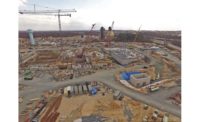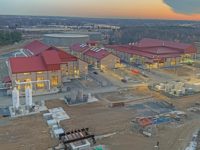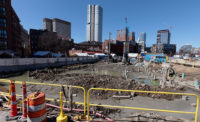Faced with a looming 2017 deadline to reduce nutrients released into the Chesapeake Bay watershed, the City of Baltimore’s Dept. of Public Works is pushing to complete more than $500 million of improvements at its Back River Wastewater Treatment Plant. Under the city’s ambitious plan, crews are constructing one of the world’s largest nitrogen-removal filters, a dozen clarifiers, six large activated-sludge reactors and new pump stations, as well upgrades to existing facilities.
“The volume and velocity of these projects is impressive,” says Shane Lippert, area manager for Archer Western Contractors, which is building two of the projects. “The city is up against the wall as far as the deadline. It was a daunting task walking in.”
Under the total maximum daily load program for the Chesapeake Bay watershed, the 180-million-gallon-a-day plant must limit nitrogen concentrations into the Back River to 3 mg/L per day by 2017 from the current 8 mg/L per day, while maintaining the current phosphorus concentrations at 0.2 mg/L.
The two current projects will upgrade the treatment plant from a capacity to 270 mgd from 180 mgd. When the job is complete, Archer Western crews will have excavated nearly one million cu yd of material, poured 225,000 cu yd of concrete and installed approximately 7,500 16-in. auger-cast piles, totaling 102 miles in length. Crews also will have installed nearly 14 miles of underground pipe, 26 miles of interior pipe and 13 miles of buried duct banks.
The $263-million enhanced nutrient-removal upgrade project is a major step in the city’s plan. It will create a massive nitrogen filtration system nearly 250 ft long by 350 ft wide, with 52 filter cells, which are each approximately 100 ft long and 30 ft deep.
Although the technology of the sand-bed filters isn’t new, it was the best choice for the Back River facility, says Per Struck, vice president at Whitman, Requardt & Associates (WRA), Baltimore, the project’s design consultant of record. “Knowing it’s an existing plant with existing infrastructure—tankage, piping and so forth—that the city has invested in over the years, we weren’t going to trash that and rebuild it,” Struck says. “The process that was selected is an add-on process at the end of the existing treatment process flow.”
Many of the projects’ biggest challenges came before excavation started. The team knew that executing the two projects would require hundreds of workers. But Lippert says Archer Western was unable to bring in enough existing staff from other parts of the country to work on the project, so additional personnel had to be hired. Archer Western’s Back River team includes about 50 staff members. In addition, the company self-performs the excavation, concrete and mechanical piping on the projects. At peak, nearly 700 craftspeople were on site, 460 of whom were hired by Archer Western. The company also had to meet Baltimore’s minimum 17% minority business enterprise and 3% women-owned business enterprise requirements.
“Fortunately, many of the other water-wastewater projects [in the Chesapeake watershed] have finished up, so there were some people available,” Lippert said. “But some of the crafts can work multiple jobs, so we were competing with casinos and bridge jobs to get some of these people.”
When the team started sitework, it had to remove a “mountain of dirt” that, during earlier projects, had been excavated at the plant and stored at the location where the new filtration system is being built, Lippert says. There were no existing tests of the dirt content before bidding; when the team tested the dirt at the site, it found elevated levels of arsenic and chromium. The team had planned to truck the dirt away for use on local residential projects, but it had to change that plan: The team decided to use most of the dirt to help cap a nearby landfill. Further, some of the dirt was moved to the site of a future Back River project to help surcharge the soils. Archer Western also had to use off-road trucks, rather than over-the-road vehicles. Lippert says two of its trucking companies went out of business during the project.
Archer Western received the notice to proceed in October 2013, so excavations had to take place during the winter. Although cold and wet weather challenged teams to stay on schedule with excavation efforts, Lippert says they found limited soil issues. “We were worried about water issues because [the plant] is close to the river, but a layer of clay kept [the water] out,” he said. “It’s something we could control with sump pumps around the perimeter.”
Although most of the existing on-site facilities use piles for foundations, WRA designed the plant with slabs. To accommodate loads, many sections of the concrete slabs had to be poured up to 6 ft thick. An X-shaped pipe gallery below the filtration system required concrete to be poured up to 12 ft deep beneath the gallery for ballast.
For portions of the concrete work, designers specified #14 rebar, which can weigh well over 100 lbs per stick. “Typically, an ironworker can carry rebar into place, but everything had to be lifted with a crane based on the size,” Lippert says.
Because of the project sequence, concrete pours ramped up in October 2014, and crews soon had to work through one of the coldest winters in recent history. “We spent a lot of money and time providing heating for forms and concrete that we didn’t expect, based on historical winters,” he says.
Weather delays caused the team to fall behind schedule, but going with double shifts in the spring and summer helped recoup time, Lippert says, adding, “We poured the last three-quarters of the concrete in the time it took to do the first quarter of it.”
Although the plant sits on 466 acres, laydown and storage areas were in short supply. Lippert says, “We couldn’t rely on just-in-time delivery on a job this big.” He adds that materials “can’t be manufactured fast enough.” For example, delivery of the sand media for the filtration system had to start in December 2013, when excavation was underway. When the job is finished, nearly 1,100 truckloads will have delivered 4,900 “super-sacks” of sand filter media; each sack measures 3 ft by 3 ft by 3 ft. “We have those [sacks] tucked all over this site,” Lippert adds.
The enhanced nutrient-removal upgrade project also required constructing a new pump station, backwash treatment facilities and flow-distribution structures. The project is scheduled to be completed in November.
Archer Western also is working on the $282-million Activated Sludge Plant 4 project, which will provide an additional 90 mgd of capacity at Back River. Spanning the area of five and a half football fields, the project includes six activated-sludge reactors, with a combined volume of 40 million gallons. The reactors will be equipped with Invent hyperboloid-shaped mixers, for increased mixing coverage and energy efficiency. A blower building will house 14 high-efficiency, 350-hp turbo blowers, which have variable speed control and a maximum capacity of 9,000 standard cu ft per minute each. “There is some unique technology on this project that will provide significant efficiency and energy savings,” says Tim Wolfe, vice president at KCI, the project’s prime consultant.
Other facilities include three sludge pump stations, twelve 120-ft-dia secondary clarifiers and a flushing-water pumping station.
Notice to proceed was issued in October 2014, again requiring the team to start excavation and foundations during the winter. KCI designed the foundations to use piles, unlike the filtration system’s slabs. The team drove 7,500 auger-cast piles to depths of between 60 and 85 ft. Lippert says the team faced highly unpredictable soil conditions and water issues. “You could pull up a fist-sized rock and then sand,” he said. “You could go 100 feet away and find something completely different. It baffled a lot of people.”
The project’s estimated completion date is in May 2017. “We think the big challenges are behind us,” Lippert said.










Post a comment to this article
Report Abusive Comment